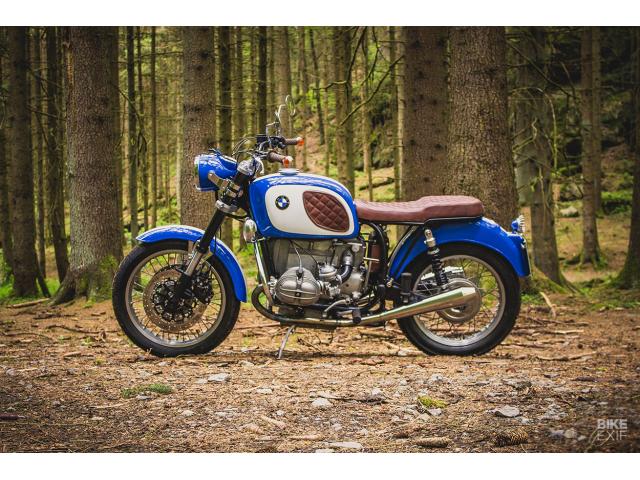1970 BMW R60/5
- Brand: BMW
It seems incredible now, but in the mid-1960s, BMW came close to abandoning motorcycle production completely. Motorcycles were suddenly becoming a losing proposition, so BMW decided to focus on developing its more profitable automobile business, a move that in time revived the company’s finances: It also meant that the BMW motorcycle range got somewhat neglected.
The then-contemporary BMW R60/2 was badly outclassed in power and handling by Italian, British and Japanese bikes. The sportier BMW R69S was available with lighter telescopic forks and a few more horses, but it was still pretty sluggish. Both bikes retained such anachronisms as a DC generator, 6-volt electrics and magneto ignition. If BMW was to continue building motorcycles, a radical change was needed. Fortunately, what the company came up became a classic BMW motorcycle – the BMW R60 /5.
New designer, new designs for the BMW R60 /5
In 1964, BMW made the decision to stay in the motorcycle business, and lured Hans-Günther von der Marwitz away from Porsche. It was his job to design the new bikes, which would be built at Spandau, near Berlin, instead of Munich. The Slash 5 series (R50/5, R60/5 and R75/5 of 500, 600 and 750cc) was announced for the 1970 season, and represented a revolution in BMW motorcycle design. Though the flat-twin BMW boxer engine layout remained, just about everything else was new.
In the engine, a new forged 1-piece crank with bolt-on flywheels replaced the old built-up, roller-bearing shaft, and used connecting rods borrowed from the 2.8-liter 6-cylinder car engine. The camshaft, formerly above the crankshaft and gear-driven, was moved below the crank and was now chain-driven. Iron-lined light alloy cylinder barrels replaced the previous cast iron types and were capped with redesigned cylinder heads fed by standard slide-type Bings on the R60 and R50 models. Other improvements included an alternator-powered 12-volt electrical system with an electric starter, though the kickstart was retained.
A much lighter tubular steel frame featured a large-diameter backbone and duplex tubes with the drive shaft built into the right side of the rear swingarm. Twin Boge rear spring/shock units were adjustable for preload with a simple hand lever. A Sachs telescopic fork of BMW design replaced the Earles fork at the front end. Light alloy wheel rims were attached to alloy hubs with a twin-leading-shoe, 7.3-inch drum front brake and similar sized single-leading-shoe drum rear.
In a bid to keep the bikes trim, BMW put considerable effort into weight reduction with extensive use of light alloy and a much lighter flywheel for the single-plate clutch. The overall effect was a machine that, at a little over 400 pounds dry, was much less bulky than the /2, had more power (46hp for the R60/5 versus just 32hp for the R60/2), handled extremely well and had better clearance thanks to the cylinders being farther away from the ground.
Period reviews
In its November 1970 test of a 1971 BMW R60 /5, Cycle magazine said that the new R60 seemed to be built to the same high quality and precision of previous BMW motorcycles.
Cycle’s tester appreciated the new bike’s increase in power, noting that it allowed the new BMW a much higher cruising speed and far livelier acceleration. Some care was needed to get the bike rolling, thanks to the combination of an aggressive clutch and a tall first gear. Similarly, the new engine needed to see 4,200rpm to get into its power band, whereas the old engine pulled strongly from 2,500rpm. That meant more gear shifting to keep the bike in its power band, causing the reviewer to wonder why BMW hadn’t used a 5-speed. There was much praise for the bike’s improved handling, although the tester noted that torque reaction from the engine could make the bike unstable at low speeds. The twin-leading-shoe front brake was also considered only just adequate, especially as the R60 was well equipped for two-up riding, with a large seat and substantial handrail.
The biggest problem testers experienced was stiction in the front fork, and the problem wasn’t properly fixed until BMW introduced a revised fork valve system for 1973. Along the way, there had been only minor changes to the /5 range, suggesting BMW got it pretty much right first time. For the 1972 season, the /5 appeared with a smaller gas tank with chrome side panels, then and forever after known as the “toaster” tank.
Later changes
During the 1973 season, a longer swingarm appeared on the /5, and while many speculated this might have been the result of handling issues, there’s no real evidence of this. Most likely, it was in anticipation of the /6 models due to be introduced the following year.
Either way, the longer wheelbase certainly didn’t hurt straight-line stability, and also allowed fitment of a larger battery and a longer seat. Along the way, the /5 earned an unapproachable reputation for reliability, and was considered at least as durable as the previous /2. Many /5s have since covered hundreds of thousands of miles with only routine servicing.
All in all, the R60/5 is an ideal useable classic. Decent power, predictable handling, excellent build quality and rock-solid dependability make it a bike you can ride regularly with confidence. Simple construction and excellent parts availability make /5s easy to keep on the road, and a large and enthusiastic community of BMW owners is always ready to help you keep your Teutonic steed running.
| Specification | |
| Production Start | 1970 |
| Country of origin | Germany |
Tags: bmw, motorcycles













